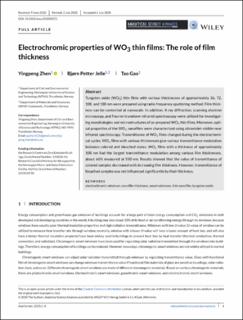| dc.contributor.author | Zhen, Yingpeng | |
| dc.contributor.author | Jelle, Bjørn Petter | |
| dc.contributor.author | Gao, Tao | |
| dc.date.accessioned | 2020-08-25T06:52:57Z | |
| dc.date.available | 2020-08-25T06:52:57Z | |
| dc.date.created | 2020-07-10T22:40:56Z | |
| dc.date.issued | 2020 | |
| dc.identifier.citation | Analytical Science Advances. 2020, 1-8. | en_US |
| dc.identifier.issn | 2628-5452 | |
| dc.identifier.uri | https://hdl.handle.net/11250/2673743 | |
| dc.description.abstract | Tungsten oxide (WO3) thin films with various thicknesses of approximately 36, 72, 108, and 180 nm were prepared using radio frequency sputtering method. Film thickness can be controlled at nanoscale. In addition, X‐ray diffraction, scanning electron microscopy, and Fourier transform infrared spectroscopy were utilized for investigating morphologies and microstructures of as‐prepared WO3 thin films. Moreover, optical properties of the WO3 nanofilms were characterized using ultraviolet‐visible‐near infrared spectroscopy. Transmittance of WO3 films changed during the electrochemical cycles. WO3 films with various thicknesses give various transmittance modulation between colored and bleached states. WO3 films with a thickness of approximately 108 nm had the largest transmittance modulation among various film thicknesses, about 66% measured at 550 nm. Results showed that the value of transmittance of colored samples decreased with increasing film thickness. However, transmittance of bleached samples was not influenced significantly by their thickness. | en_US |
| dc.language.iso | eng | en_US |
| dc.publisher | Wiley | en_US |
| dc.rights | CC BY 4.0 | * |
| dc.rights.uri | https://creativecommons.org/licenses/by/4.0/ | * |
| dc.subject | Electrochromic windows | en_US |
| dc.subject | Nanofilm thickness | en_US |
| dc.subject | Smart windows | en_US |
| dc.subject | Thin nanofilm | en_US |
| dc.subject | Tungsten oxide | en_US |
| dc.title | Electrochromic Properties of WO3 Thin Films: The Role of Film Thickness | en_US |
| dc.type | Journal article | en_US |
| dc.description.version | publishedVersion | en_US |
| dc.rights.holder | © 2020 The authors | en_US |
| dc.subject.nsi | VDP::Teknologi: 500 | en_US |
| dc.source.pagenumber | 1-8 | en_US |
| dc.source.journal | Analytical Science Advances | en_US |
| dc.identifier.doi | 10.1002/ansa.202000072 | |
| dc.identifier.cristin | 1819235 | |
| dc.relation.project | Norges forskningsråd: 193830 | en_US |
| dc.relation.project | Norges forskningsråd: 245963/F50 | en_US |
| cristin.ispublished | false | |
| cristin.fulltext | original | |

